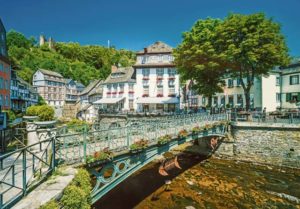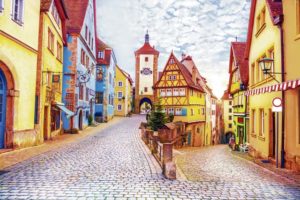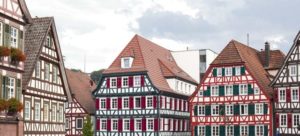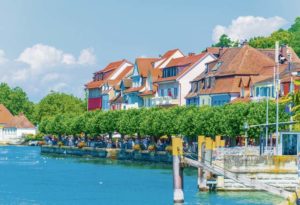Continued from March 30 and April 6

Monschau: On the westernmost edge of Germany along the Belgian border, is the town of Monschau. Monschau is located in the District of Aachen, in the state of North Rhine Westphalia. Traversed by the river Rur and surrounded by mountains, its clean air, quiet atmosphere and abundance of nature have made Monschau an ideal location for wellness retreats. In 1996, Monschau was named a health resort town. The half-timbered buildings in the town center have remained unchanged for the last 300 years. Along the river, half-timbered houses line the landscape creating a breathtaking backdrop. Unlike the brightly colored structures in Limburg a.d. Lahn, the heavy use of slate in Monschau gives the village a monotone greyish hue. During WWII, the town was at the northern-most point in the battlefront making it a strategic location during the Battle of the Bulge. Every summer, Monschau hosts an open air classical music festival on the castle grounds and every winter, the popular Christmas market draws thousands of visitors. Monschau is located 245km north west of Kaiserslautern. http://www.monschau.de/de/

Rothenburg ob der Tauber: Traversing across Germany back to the east, on a plateau above the Tauber River and in the Franconia region of Bavaria, lies Rothenburg ob der Tauber (there are two Rothenburg’s so be sure you’re heading towards the one in the district of Ansbach). While Rothenburg does not sit on the German Timber-Frame Road, it is part of the popular Romantic Road. Rothenburg dates back to the year 950. Today, it is known as one of the more complete medieval villages and draws many tourists from all over the world. In the old town are timber-framed houses but it is also known for the well preserved Gothic and Renaissance buildings. In large part, the village is stuck back in time because in 1634, the Bubonic plague killed the majority of the town’s population. The town had no money to rebuild so it remained in its original state for many hundreds of years. During WWII, Rothenburg was believed to be a near perfect example of German life so it was both occupied and protected by German soldiers. Allied forces dropped bombs on the village and succeeded in destroying a part of it before sending a small contingent of soldiers to negotiate a German surrender. Against Hitler’s orders to stay, the local German commander surrendered the town in hopes of preventing further damage. After the war, the town was quickly repaired. Rothenburg ob der Tauber is located 242 km east of Kaiserslautern (on A6). http://www.rothenburgobdertauber.org

Calw: Heading south-west and back towards the Fachwerkstrasse in the state of Baden-Wuerttemberg, is the district of Calw. There are 13 subdivisions within the district. If you’re looking for the historical city center, you’ll want to follow directions towards the subdivision of Calw. The village is located about 33km west of Stuttgart, in the Northern Black Forest. The cave of Bruderhoehle, a 12 meter long cave, which can be explored without restrictions, can be found on the west slope of the Nagold Valley. The village is first mentioned in 1037, and grew as a result of expansion by the Earl of Calw. Today, the old town remains practically untouched which draws many tourists. In addition to its spectacular scenery and pristine condition, bibliophiles will be drawn to the fact that Nobel-prize-winning writer Hermann Hesse is the most prominent resident of Calw. From Kaiserslautern in the direction of Stuttgart, Calw can be reached in 177km when traveling on the A6. https://www.calw.de/welcome

Meersburg: The southernmost town on the Deutsche Fachwerkstrasse is the village of Meersburg. Meersburg dates back to the year 630. Its name literally means, “Castle on the sea,” and is likely derived from its two castles and its location on Lake Constance. The Old Castle is open for visitors and the New Castle is now a museum. There are also two medieval town gates that remain from the original fortification. Meersburg is also home to vineyards known for producing rosé wines called, “Weissherbst.” Though it’s safe to say almost everyone is familiar with the term, “mesmerized,” few know that the term originated from the 18th Century doctor, Franz Anton Mesmer, who died in 1815 in Meersburg and is buried near the upper town gate. To reach Meersburg from Kaiserslautern, follow the A81 south for approximately 363km. https://www.meersburg.de/de/Home
About the author: Ruth Cuevas is a freelance writer, Adjunct Professor and Yoga instructor who has lived in six countries in three continents since 2008. Her writing can be seen in ATOD Magazine www.atodmagazine.com and Elephant Journal www.elephantjournal.com. You can follow her travels on instagram at @mymotorcyclediaries. Her goal is to keep her blog updated www.mymotorcyclediaries.net.


